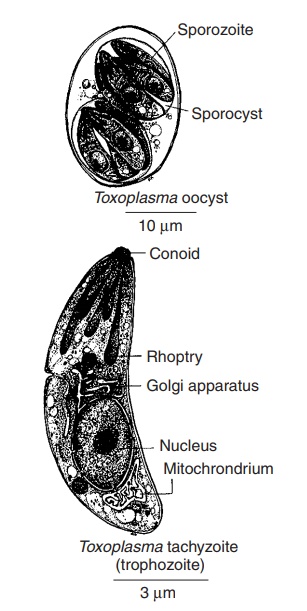Chapter: Medical Microbiology: An Introduction to Infectious Diseases: Sporozoa
Toxoplasma Gondii - Parasitology
TOXOPLASMA GONDII
PARASITOLOGY
Like the plasmodia, Toxoplasma gondii, the cause of toxoplasmosis, is an obligate intra-cellular sporozoan. It differs from Plasmodium in that both sexual and asexual reproduc-tive cycles occur within the gastrointestinal tract of felines, the definitive host. The disease is transmitted to other host species by the ingestion of oocysts passed in the feces of infected felines.
MORPHOLOGY
T. gondii was first demonstrated in 1908 in the gondi, an African rodent, by Nicolle andMarceaux. Its name, derived from the Greek toxo (arc), is based on the characteristic shape of the organism. All strains of this parasite appear to be closely related antigeni-cally. The major morphologic forms of the parasite are the oocyst, trophozoite, and tissue cyst.
Oocyst
The oocyst is ovoid, measures 10 to 12μm in diameter, and possesses a thick wall that makes it resistant to most environmental challenges. It may be destroyed by heat in ex-cess of 66°C and chemicals such as iodine and formalin. In its immature form, the center of the cyst lacks internal structure. With maturation two sporocysts appear, and later four sporozoites may be discerned within each sporocyst. Sporulation does not occur at tem-peratures below 4°C or above 37°C. This form is responsible for the spread of the para-sites from felines to other warm-blooded animals via the fecal–oral route.
Tachyzoite (Trophozoite)
The term “trophozoite” is used in its broadest sense to refer to the asexual proliferative forms responsible for cell invasion and clinical disease. In different stages of the asexual cycle it is referred to by several other terms, including merozoite and tachyzoite. It is crescent or arc shaped, measures 3 by 7 m, and can invade all nucleated cell types. Al-though tachyzoites are obligate intracellular organisms, they may survive extracellularly in a variety of body fluids for periods of hours to days. They cannot, however, survive the digestive activity of the stomach and therefore are not infective on ingestion.
Tissue Cysts
Cysts measure 10 to 200μm in diameter. The contained organisms, referred to as brady-zoites, are similar to tachyzoites, but are smaller and divide more slowly. Tissue cysts are resistant to digestive enzymes, and like oocysts, are infectious to the animal that ingests them. They survive normal refrigerator temperatures but are killed by freezing and thaw-ing and by normal cooking temperatures.

LIFE CYCLE
Definitive Host
Sexual reproduction of T. gondii occurs only in the intestinal tract of felines, most impor-tantly in the domestic cat. Ingested parasites enter the epithelial cells of the ileum by mechanisms that remain poorly defined. Intracellularly, the trophozoites reside within a membrane-bound vacuole and undergo schizogony. With cell rupture, merozoites are re-leased. The merozoites infect adjacent epithelial cells; they then repeat another asexual cy-cle or eventually differentiate into gametocytes, initiating sexual reproduction. Fusion of the mature male and female gametes leads to the formation of an oval, thick-walled oocyst that is then shed in the feces. In the typical infection, millions of these structures are re-leased daily for 1 to 3 weeks. The oocysts are immature at the time of shedding and must complete sporulation in the external environment. In this process, two sporocysts, each containing four sporozoites, develop within each oocyst. The time required for sporulation varies from 1 day to 3 weeks, depending on the ambient temperature and moisture. Once mature, the resistant oocysts may remain viable and infectious for many years in soil.
Intermediate Hosts
After ingestion by a susceptible warm-blooded animal, sporozoites are released from the disrupted oocyst and enter macrophages. Within these cells, they are transported through the lymphohematogenous system to all organ systems. Continued intracellular schizo-gony results in macrophage rupture and release of new parasites, which may invade any adjacent nucleated host cell and continue the asexual cycle. With the development of host immunity, many of the parasites are destroyed. Within the cells of certain organs, particu-larly the brain, heart, and skeletal muscle, the trophozoites produce a membrane that sur-rounds and protects them: within this tissue cyst, multiplication continues at a more leisurely pace. Eventually, cysts that measure up to 200μm in diameter and contain more than a thousand organisms are produced. These cysts persist intact for the life of the host or rupture, producing parasitologic relapse. If they are ingested by a carnivore, they sur-vive the digestive enzymes and initiate infection in the new host.
Related Topics